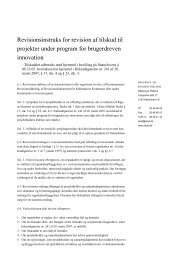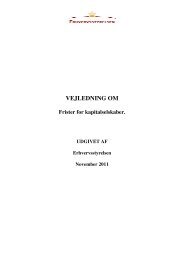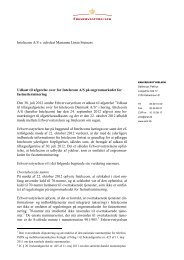Risk-Based Approach â Guidance for Money Service Businesses
Risk-Based Approach â Guidance for Money Service Businesses
Risk-Based Approach â Guidance for Money Service Businesses
Create successful ePaper yourself
Turn your PDF publications into a flip-book with our unique Google optimized e-Paper software.
<strong>Risk</strong>-<strong>Based</strong> <strong>Approach</strong> – <strong>Guidance</strong> <strong>for</strong> <strong>Money</strong> <strong>Service</strong> <strong>Businesses</strong> - July 2009 Proportionate Supervisory Actions to support the <strong>Risk</strong>-<strong>Based</strong> <strong>Approach</strong>88. Supervisors should seek to identify weaknesses through an effective programme of both on-siteand off-site supervision 9 , and through analysis of internal and other available in<strong>for</strong>mation.89. In the course of their examinations, supervisors should review a MSB‟s AML/CFT riskassessments, as well as its policies, procedures and control systems to arrive at an overall assessment of therisk profile of the business and the adequacy of its mitigation measures. Where available, assessmentscarried out by or <strong>for</strong> the business may be a useful source of in<strong>for</strong>mation. The assessment should includesample transaction testing of customer transactions to validate the assessment. The supervisor‟s assessmentof management‟s ability and willingness to take necessary corrective action is also a critical determiningfactor. Supervisors should use proportionate actions to ensure proper and timely correction of deficiencies,taking into account that identified weaknesses can have wider consequences. Generally, systemicbreakdowns or inadequate controls will result in the most severe supervisory response.90. Nevertheless, it may happen that the lack of detection of an isolated high risk transaction, or oftransactions of an isolated high risk customer, will in itself be significant, <strong>for</strong> instance where the amountsare significant, or where the money laundering and terrorist financing typology is well known, or where ascheme has remained undetected <strong>for</strong> a long time. Such a case might indicate an accumulation of weak riskmanagement practices or regulatory breaches regarding the identification of high risks, transactionmonitoring, staff training and internal controls, and there<strong>for</strong>e, might alone justify supervisory action.91. Supervisors should be in a position to compare risk factors and procedures used by peer MSBs.This will, among other objectives, assist the supervisors in better understanding how MSBs are developingand implementing a risk-based approach, as well as in identifying potential deficiencies. Similarly,supervisors can and should use their knowledge of the risks associated with products, services, customersand geographic locations to help them evaluate the MSB‟s money laundering and terrorist financing riskassessment, with the understanding, however, that they may possess in<strong>for</strong>mation that has not been madeavailable to MSBs and, there<strong>for</strong>e, MSBs would not have been able to take such in<strong>for</strong>mation into accountwhen developing and implementing a risk-based approach. Supervisors (and other relevant stakeholders)are encouraged to use that knowledge to issue guidelines to assist MSBs in managing their risks. WhereMSBs are permitted to determine the extent of the CDD measures on a risk sensitive basis, this should beconsistent with guidelines issued by the competent authorities 10 . An assessment of the risk-based approachwill, <strong>for</strong> instance, help identify cases where businesses use excessively narrow risk categories that do notcapture all existing risks, or adopt criteria that lead to the identification of a large number of higher riskrelationships, but without providing <strong>for</strong> adequate additional due diligence measures.92. In the context of the risk-based approach, the primary focus <strong>for</strong> supervisors should be todetermine whether or not the MSB‟s AML/CFT compliance and risk management programme is adequateto: (a) meet the minimum regulatory requirements, and (b) appropriately and effectively mitigate the risks.The supervisory goal is not to prohibit high risk activity, but rather to be confident that MSBs haveadequately and effectively implemented appropriate risk mitigation strategies.93. Under FATF Recommendation 29, supervisors should impose adequate sanctions <strong>for</strong> failure tocomply with statutory and regulatory requirements to combat money laundering and terrorist financing,and effective AML/CFT supervision requires that the supervisor has available an appropriate range of910FATF Methodology <strong>for</strong> Assessing Compliance with the FATF 40 Recommendations and the FATF 9Special Recommendations, criteria 29.2.FATF Recommendations 5 & 25, Methodology <strong>for</strong> Assessing Compliance with the FATF 40Recommendations and the FATF 9 Special Recommendations, Essential Criteria 25.1 and 5.12.© 2009 FATF/OECD - 23
















